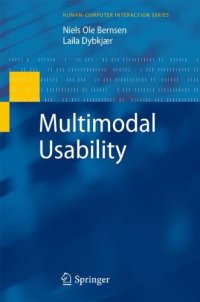
Ebook: Multimodal Usability
- Genre: Computers
- Tags: User Interfaces and Human Computer Interaction, System Performance and Evaluation, Media Design
- Series: Human-Computer Interaction Series
- Year: 2010
- Publisher: Springer-Verlag London
- Edition: 1
- Language: English
- pdf
Multimodal Usability demonstrates several major generalisations of human-computer interaction and extends the traditional focus on graphical user interfaces to all input/output modalities accessible to vision, hearing, and touch.
Multimodal Usability can help make a multimodal interactive system usable no matter if you are building a work tool or a game, and whether your system models aspects of people, like a virtual (or robot) companion or friend, or not.
Successful implementation can be achieved using the following usability development steps:
(1) Augment system model specification with an AMITUDE model of use specified in terms of Application type, Modalities, Interaction type, Task, User, Device and Environment of use.
(2) Apply usability methods to collect the usability data needed at any time. A toolbox of 24 key methods are presented in a common format. Methods are of five kinds: question-answering, meetings with discussion, observation, imagination, and interaction with the system.
(3) For each method application, post-process, annotate, analyse, report, and act on the data to improve system model usability.
Three multimodal system Cases are included to illustrate usability development from idea to user test of the implemented prototype.
Multimodal Usability assumes no prior knowledge about usability and human-computer interaction.
This book is about how to develop and evaluate multimodal systems which are usable by, or fit, people. The main objective is to answer the practical question of what system developers need to know and be able to do in order to develop usable new multimodal applications. The need to know is addressed in the first part of the book, in which the role of development and evaluation for multimodal usability in the software engineering life-cycle is described, and 9 key multimodal usability parameters are presented as well as theory of modalities and multimodality. The need to be able to do is addressed in the second part of the book. The distinction between interleaved and iteratively performed (i) development for multimodal usability and (ii) evaluation for usability is discussed.